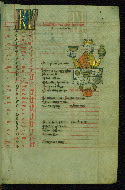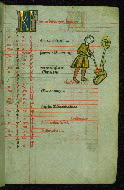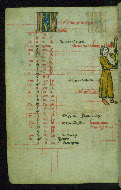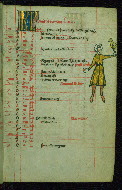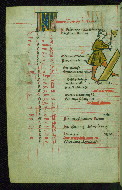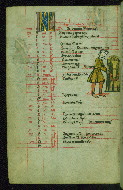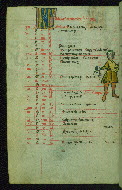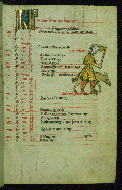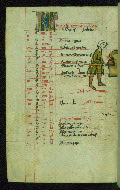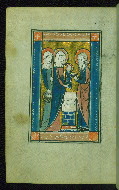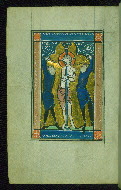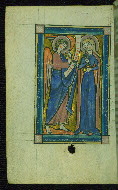Home > Digitized Walters Manuscripts
This document is a tranformation of a TEI P5 XML manuscript description incorporating images. If you have trouble reading special or non-Latin characters on this page, please make sure you have appropriate Unicode fonts installed and an up-to-date web browser.
Walters Ms. W.117, Psalter and Office of the Dead
Browse images (Browse images in a new window) | TEI in XML format
W.117
Psalter and Office of the Dead
Dating from ca. 1265-80, this manuscript includes twelve calendar illustrations, four extant full-page miniatures, and eight historiated initials. Originally composed of the Psalter and Office of the Dead (for Premonstratensian use), it was appended to at a later time to include Hours of the Virgin of an unidentified use but which is related to Thérouanne and Saint Omer. The illumination is a composite of Ghent, Hainaut, and Liège styles. There is a strong presence of heraldry throughout; armorial shields and arms, birth notices, and other family entries cited on back flyleaves connect this Psalter to the Crohin family of Hainaut. Two births are specifically mentioned: Antonet, daughter of Jun de Crohin and Marguerite de Leugney on October 25, 1577, and Jan de Crohin, brother of Antonet, born January 24, 1579.
Ca. 1265-1280 CE
Hainaut (?)
Book
Devotional
The primary language in this manuscript is Latin. The secondary language of this manuscript is French, Old (842-ca.1400).
Parchment
Well-selected and prepared medium- to heavy-weight parchment; many original stitch holes; flyleaves are a different parchment, added at rebinding in the fifteenth or early sixteenth century
Foliation: i+199
First three leaves are from later rebinding and are not part of quire structure of book; however, the first has been given an "A" and counted as a flyleaf, while the next two have been counted as folios 1 and 2, but should technically be flyleaves; modern pencil foliation, upper right corners, rectos
Formula: Quire 1: 4, with first folio of ruled parchment leaf used as front pastedown and covered with red silk, second folio as front flyleaf i, third and fourth folios with modern penciled foliation of fols. 1-2 (front pastedown-fol. 2); Quire 2: 4 (fols. 3-6); Quire 3: 2, with third and fourth folios added, third and fourth folios later removed(?) (fols. 7-8); Quire 4: 2, with third folio added (fols. 9-11); Quires 5-14: 8 (fols. 12-91); Quire 15: 6, with first and eighth folios hooked after fols. 92 and 99 (fols. 92-99); Quire 16: 8 (fols. 100-107); Quire 17: 10 (fols. 108-117); Quires 18-19: 8 (fols. 118-133); Quire 20: 10 (fols. 134-143); Quire 21: 8 (fols. 144-151); Quire 22: 8, with sixth folio removed and seventh folio added after fol. 156, probably contemporary with quire 1 (fols. 152-158); Quires 23-26: 8 (fols. 159-190); Quire 27: 6 (fols. 191-196); Quire 28: 4, with fourth folio as back pastedown under red silk (fols. 197-199)
Signatures: Quire marks occasionally visible on last verso of quire, centered in lower margins, beginning on fol. 27v; some in brown ink and others in blue (likely later); some signatures extant but mostly cropped, eg. fols. 126r-129r
Comments:
13.1 cm wide by 19.2 cm high
9.1 cm wide by 13.1 cm high
- Columns: 1
- Ruled lines: 19
- Calendar ruled in red, original text ruled in plummet, and added text ruled in brown ink; layout does not apply to calendar: written space 10 cm x 13.3 cm, 5 columns, 33 lines; added text has same layout as original text
- Title: Psalter-Hours
- Contents: Psalter and Office of the Dead, with added Hours of the Virgin and armorials
- Hand note: All text written in slight variants of textura
- Decoration note: Four extant full-page miniatures; twelve calendar marginal illustrations; eight historiated initials at major psalm openings (7-11 lines); decorated illuminated initials at secondary psalm openings with thick, long ascenders/descenders in gold against blue and rose grounds (2 lines); "KL" in calendar in same colors (5 calendar lines); small decorated initials in gold with blue or rose penwork at versals (1 line); armorial shields added in fifteenth or sixteenth century in front of book and passim; in text added in fifteenth century: large foliate initials at major text openings, with bright orange added to palette (6-7 lines); have attempted to match size and effect of medium and small initials; linefillers throughout in jagged, comb effect in blue, red, and occasionally gold; rubrics in red; text in dark brown ink for original section of manuscript, medium brown ink for added text
- Title: Flyleaves with armorial shields
- Contents: Flyleaves added at time of rebinding, ca. fifteenth to sixteenth century; armorial shields painted at this time and include arms of Crohin family
- Title: Calendar
- Rubric: Januarius habet dies xxxi. luna xxx.
- Contents: Calendar one third to half full, graded in red and black; references to zodiac, seasons, and "dog days" in red to right of feasts; some erasures and additions throughout; contents suggest use in diocese of Cambrai, with saints of importance to Liège, Tournai, and northeast France; saints of note include Hilary and Remigius (on same line in calendar, but should be Jan. 12 and Jan. 13), Felix (Jan. 13, usually Jan. 14), Marcellus (Jan. 15), Agnes (Jan. 20), Ignatius and Brigid (Feb. 1), Adrian (Mar. 4, "elevacio"), Vindicianus (Mar. 11), Benedict (Mar. 21, "deposicio"), Walburga (May 1), Gregory (May 9), Servatius (May 13), Victor and Corona (May 14), Pentecost (May 15), Nicodemus and Reverianus (June 1), Marcellinus and Peter bishop (June 2), Basil (June 12, usually June 14), Landelinus (June 15), Salvius (June 26), Amalberga (July 10), Capture of Jerusalem (July 15, end of first crusade), Wandregisil (July 22), Cassianus (Aug. 5), Gaugeric (Aug. 11), Hunegundis (Aug. 25), Remacle (Sept. 3), Bertin (Sept. 5), Humbert (Sept. 6), Nativity of the Virgin and Adrian (Sept. 8), Dorotheus (Sept. 9), Aichard (Sept. 15), Bavo and Piatus (Oct. 1), Ghislain (Oct. 9), Donatianus (Oct. 14), Quintinus and Foillan (Oct. 31), All Souls (Nov. 1), All Saints (Nov. 2), Leonard and Winnoc (Nov. 6), Livin (Nov. 12), Maxellendis (Nov. 13), Peter of Alexandria (Nov. 25), Eligius and Natalia (Dec. 1; latter is unique here as far as is known, was wife of St. Adrian), Gentianus (Dec. 11), Autbert (Dec. 13); added early to the calendar: Peter martyr (Apr. 29, canonized 1253), and Dominic (May 24, translation)
- Decoration note: Labors of the month depicted on each calendar page
- Title: Prefatory image cycle
- Decoration note: Three full-page miniatures on versos; possible fourth extant full-page miniature in manuscript, now fol. 158v, likely moved from prefatory cycle when Hours of the Virgin added in fifteenth century
- Title: Liturgical Psalter
- Incipit: Beatus vir
- Contents: Eight-partite psalter; seventh division should be at Ps. 97, but is at Ps. 95
- Decoration note: Historiated initials fols. 12r, 31r, 43v, 55r, 67r, 81v, 92v, and 108r
- Title: Canticles
- Incipit: Confitebor tibi
- Contents: Fifteen canticles, including three creeds, the Lord's Prayer, and Hail Mary
- Title: Litany, petitions, and collects
- Incipit: Kyrieleyson
- Contents: Fols. 147v-149v: litany, including sixteen disciples, from Peter to Mark; thirty-one martyrs, including Stephen, Adrian, George, Gereon, Lambert, Livin, Chrysogonus, John/Paul, Cosmas/Damian, Hermes, Quintinus, Blasius, and Marcellinus/Peter bishop; twenty confessors including Servatius, Remigius, Vedast, Amandus, Benedict, Ghislain, Humbert, Aegydius, Bertin, Bavo, and Eligius; seventeen virgins including Mary Magdalene, Mary Egyptian, Natalia, Felicitas, Aldegund, Walburgus, Amalberga, and Maxellendis; fols. 149v-150r: petitions, including one referring to the capture of Jerusalem as in calendar; fols. 150v-151r: five collects
- Title: Office of the Dead
- Incipit: Placebo Domino in regione vivorum
- Contents: Office of the Dead for Premonstratensian use; no rubrication; ends imperfectly, with last prayer completed in later hand on leaf added in fifteenth century
- Title: Added Hours of the Virgin
- Rubric: Les heures notre dame
- Incipit: Domine labia mea
- Contents: Added likely in the fifteenth century
- Decoration note: Full-page miniature fol. 158v, likely originally part of prefatory cycle at beginning of manuscript and moved here during the fifteenth century to function as an opening image for the Hours of the Virgin
- Title: Added Hours of the Cross
- Rubric: Les heures de le crois
- Incipit: Domine labia mea
- Contents: Added likely in the fifteenth century
- Title: Added Hours of the Holy Spirit
- Rubric: Les heures dou saint espir
- Incipit: Domine labia mea
- Contents: Added likely in the fifteenth century
- Title: Ownership entries
- Contents: Various ownership inscriptions and birth/death notices added by several hands in sixteenth possibly through early seventeenth century
fol. 1v:
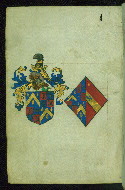
- Title: Armorial shields, including Crohin family arms
- Form: Armorials
- Comment:
Heraldry added in fifteenth or sixteenth century. Armorials of Crohin family composed of blue grounds with a gold chevron and three golden ears of corn (?).
fol. 2v:
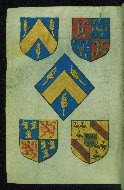
- Title: Armorial shields, including heraldry of Crohin family
- Form: Armorials
- Comment:
Heraldry added in fifteenth or sixteenth century. Armorials of Crohin family composed of blue grounds with a gold chevron and three golden ears of corn (?).
fol. 3r:
fol. 3v:

- Title: Woman holding two lit candles for Candlemas
- Form: Marginal illumination
- Text: Calendar: February
fol. 4r:
fol. 4v:
fol. 5r:
fol. 5v:
fol. 6r:
fol. 6v:
fol. 7r:
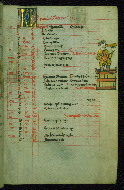
- Title: Man trampling grapes while drinking wine
- Form: Marginal illumination
- Text: Calendar: September
fol. 7v:
fol. 8r:
fol. 8v:
fol. 9v:
fol. 10v:
fol. 11v:
fol. 12r:
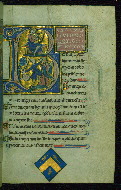
- Title: Initial "B" with King David playing the harp and young David decapitating Goliath
- Form: Historiated initial "B," 11 lines
- Text: Psalm 1
fol. 31r:
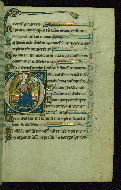
- Title: Initial "D" with King David pointing to his eye before the face of God
- Form: Historiated initial "D," 7 lines
- Text: Psalm 26
fol. 43v:
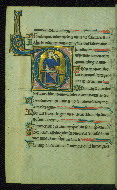
- Title: Initial "D" with King David pointing to his mouth
- Form: Historiated initial "D," 7 lines
- Text: Psalm 38
fol. 55r:
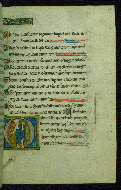
- Title: Initial "D" with fool eating a loaf and carrying a club
- Form: Historiated initial "D," 5 lines
- Text: Psalm 52
fol. 67r:
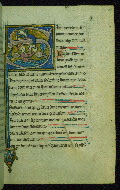
- Title: Initial "S" with King David in water being blessed by God
- Form: Historiated initial "S," 7 lines
- Text: Psalm 68
fol. 81v:

- Title: Initial "E" with King David playing bells
- Form: Historiated initial "E," 7 lines
- Text: Psalm 80
fol. 92v:
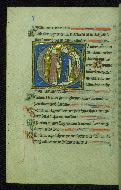
- Title: Initial "C" with singing clerics
- Form: Historiated initial "C," 7 lines
- Text: Psalm 95
- Comment:
The scroll they hold is inscribed "Bonne conpangie quant."
This image should be with Ps. 97, not Ps. 95.
fol. 108r:
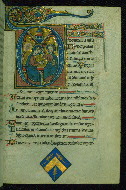
- Title: Initial "D" with the coronation of the Virgin, men with sticks and bucklers confronting each other in the extender, and arms of Crohin family added below
- Form: Historiated initial "D," 10 lines
- Text: Psalm 109
- Comment:
Arms of Crohin family in lower margin added in fifteenth or sixteenth century.
fol. 158v:
The binding is not original.
Rebound in Belgium, late fifteenth or early sixteenth century; deep red velvet over leather-covered wood boards; piping composed of gilded silver, gold, and red silk thread lines edges of boards; red, white, and green silk endbands sewn to velvet cover; page edges gilded, gauffered with a diamond and rosette pattern; matching velvet straps with piping attached to inside of upper board and clasp to lower board; fasteners in gilded silver, with golden "P" for Peissant family against a ground of deep blue enamel; clasps likely nineteenth-century: close comparison exists on manuscript at Getty, also connected to Crohin family, which was bound in Belgium in the first half of the nineteenth century (see the Crohin-La Fontaine Hours, Getty Ms. 23)
Created ca. 1265-80, likely in the Hainaut region of Flanders (illumination style reveals Hainaut influence and also that of Ghent and Liège); Randall suggests original owner may have been connected with the Abbey of Grammont (Geraardsbergen) in Hainaut, a foundation dedicated to St. Adrian, who is prominent in the calendar
Crohin family of Hainut, owned possibly from fifteenth or sixteenth century, their armorial shields added twice on fol. 2v and in lower margins of fols. 12r, 108r, 159r, and 184r; birth and death notices for Crohin family members beginning in 1577, including those of brother and sister Jan and Antonet de Crohin, recorded on fols. 195v-197r; aunt listed, "Madamoyselle de Peissant," may represent branch of family from which "P" on clasps was derived
Léon Gruel and Edmond Engelmann, Paris, late nineteenth or early twentieth century; their bookplate inscribed "No. 467" on inside of upper board, and same number on matching dealer description (removed, but imaged here); Gruel catalog number, "No. 3," penciled in on top left corner of dealer note refers to its number in Gruel's undated catalog
Henry Walters, Baltimore, by purchase from Gruel between 1895 and 1931
Walters Art Museum, 1931, by Henry Walters' bequest
De Ricci, Seymour. Census of Medieval and Renaissance Manuscripts in the United States and Canada. Vol. 1. New York: H. W. Wilson Company, 1935; p. 772, cat. no. 98.
Miner, Dorothy. The History of Bookbinding, 525-1950 A.D. Exhibition Catalogue: Baltimore, Walters Art Gallery. Baltimore: Trustees of the Walters Art Gallery, 1957; cat. no. 113, Pl. xxix.
Carlvant, Kerstin B. E. "Ghent: Blijlokemuseum 60-61." In Gent Duizend jaar kunst en cultuur. Organized by A. van den Kerhove. Exhibition Catalogue: Ghent, Blijlokemuseum. Ghent: Dienst voor Culturele Zaken-Stad Gent, 1975; p. 346, ref. under cat. no. 572.
Carlvant, Kerstin B. E. "Thirteenth-Century Illumination in Bruges and Ghent." Ph.D. diss., Columbia University, 1978; pp. 367-368, Table 5A and passim, fig. 9.
Oliver, Judith. Gothic Manuscript Illumination in the Diocese of Liege (c. 1250-c. 1330). Brepols: Peeters Publishing, 1988; p. 309.
Randall, Lilian M. C. Medieval and Renaissance Manuscripts in the Walters Art Gallery. Vol. 3, Belgium, 1250-1530. Baltimore and London: Johns Hopkins University Press in association with the Walters Art Gallery, 1997; pp. 10-16, cat. no. 216.
Sandler, Lucy Freeman. "Psalter: In Latin, Metz." In The Splendor of the Word: Medieval and Renaissance Illuminated Manuscripts at the New York Public Library. Edited by Jonathan J. G. Alexander, James H. Marrow, and Lucy Freeman Sandler, 213-216. New York: New York Public Library, 2005; p. 216, ref. under cat. no. 43.
Christie's. Valuable Manuscripts and Printed Books, Sale 7399. King Street, London, 2007; ref. under lot 33 (Psalter with Calendar and Litany, in Latin, Illuminated Manuscript on Vellum).
Principal cataloger: Randall, Lilian M.C.
Cataloger: Herbert, Lynley
Editor: Herbert, Lynley
Copy editor: Wallace, Susan
Conservators: Owen, Linda; Quandt, Abigail
Contributors: Emery, Doug; Herbold, Rebekah; Noel, William; Schuele, Allyson; Tabritha, Ariel; Toth, Michael B.; Valle, Chiara; Wiegand, Kimber
The Walters Art Museum
Licensed for use under Creative Commons Attribution-ShareAlike 3.0 Unported Access Rights, http://creativecommons.org/licenses/by-sa/3.0/legalcode. It is requested that copies of any published articles based on the information in this data set be sent to the curator of manuscripts, The Walters Art Museum, 600 North Charles Street, Baltimore MD 21201.
